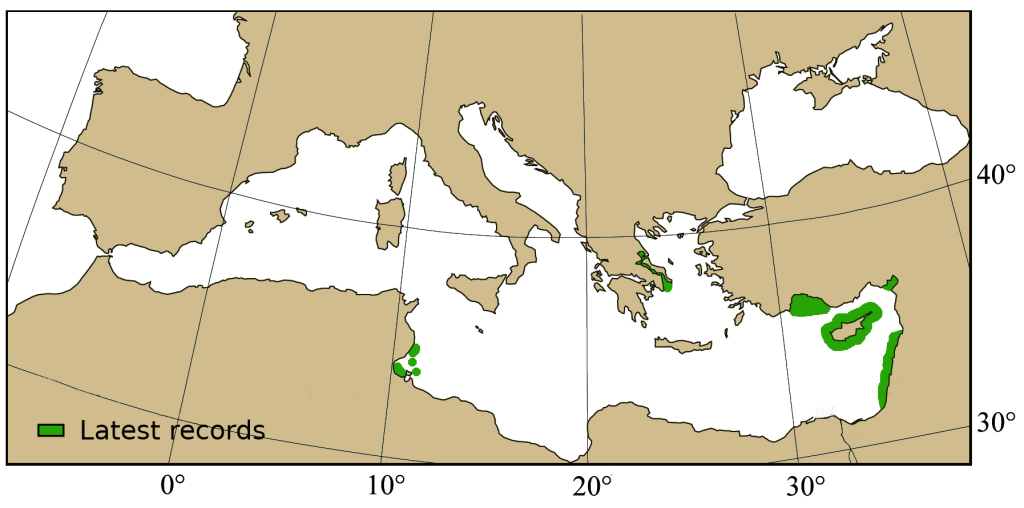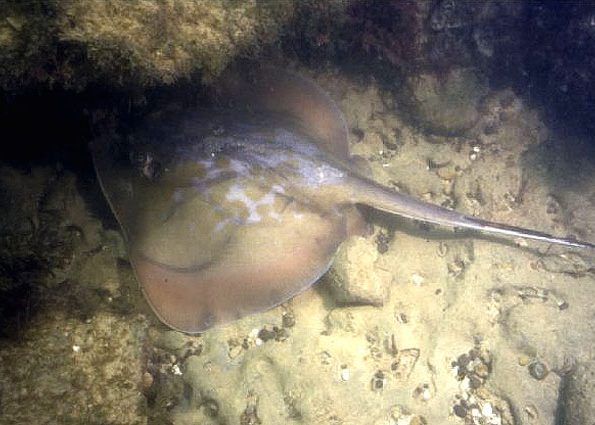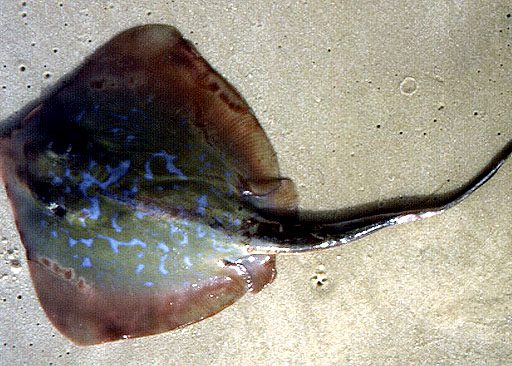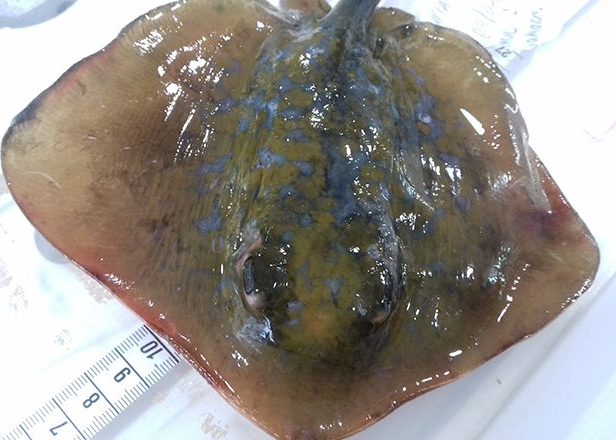Dasyatis marmorata
Common name: Marbled Stingray
Order: Myliobatiformes
Family: Dasyatidae
Synonyms: Dasyatis chrysonota marmorata, Trygon pastinaca marmorata
Misidentifications: Dasyatis tortonesei, Dasyatis pastinaca, Dasyatis chrysonota
Short description
Small stingray. Snout and disc angular. Tail less than twice body length. Disc without spines. One dart on the base of the tail.
Color: Golden-brown disc with spot/marbling blue. White ventral surface. Tail dark and without bands.
Measurements:
- Disk width (DW): up to 44 cm
- Total length (TL): up to 60 cm
Swimming pattern: Undulatory locomotion.
Biology / Ecology
Feeds on crabs, mantis shrimps, amphipods, worms and fishes.
Reproduction: Viviparous (aplacental viviparity). Size at maturity (TL): 32 cm female, 27-30 cm male. Gestation period: 3 months. Juveniles per litter: 4 per year.
Habitat: Demersal species in temperate water, inhabits coastal and shallow waters. Benthic on continental shelf on sandy and muddy bottoms, sometimes near rocky reefs. Found from 12 to 100 m deep. Found in deeper offshore areas during the winter season.
Previously wrongly identified in the Red Sea (mistaken for Taeniurops meyeni).
Distinguishing characteristics
- Prominent elongated snout.
- Rhomboidal disc without spines.
- Conspicuous bright blue blotches and branching lines on a golden background.
Myliobatiformes: No caudal and anal fin. Thin tail like a whip.
Dasyatidae: Batoids with depressed bodies.
Distribution
Worldwide: Eastern Atlantic from Morocco to Mauritania.
Mediterranean: Recorded in south of Tunisia, along the coast of Israel, Lebanon, Turkey and Greece. Absent from Black Sea.
- Occurrence: Rare.
- Latest records: Cyprus (2018-2022), Maliakos Gulf – Grece (2019), Lebanon (2014), Iskenderun Bay – Turkey (2013), Gulf of Antalya – Turkey (2010), Southern Tunisia (2009), Israël (2004).

Any recent observation not on the map?
Contact us!
Conservation
Threats: Caught as bycatch by bottom trawl fisheries.
Protection level:
- Europe: Data Deficient (IUCN 2015, last assessment: 2015)
- Global: Near Threatened (IUCN 2021, last assessment: 2020)
- Mediterranean: Data Deficient (IUCN 2016, last assessment: 2016)
Key references
- Carpentieri P., Nastasi A., Sessa M., Srour A. 2021. Incidental catch of vulnerable species in Mediterranean and Black Sea fisheries – A review. General Fisheries Commission for the Mediterranean – Studies and Reviews 101: I-317.
- Chatzispyrou A., Gubili C., Laiaki M., Mantopoulou-Palouka D., Kavadas S. 2020. First record of the marbled ray, Dasyatis marmorata (Elasmobranchii: Dasyatidae), from Greece (central Aegean Sea). Biodiversity data journal 8: e51100.
- Erguden D., Turan C., Gurlek M., Uyan A., Reyhaniye A.N. (2014). First record of Marbled Stingray, Dasyatis marmotata (Elasmobranchii: Myliobatiformes: Dasyatidae), on the coast of Turkey, north-eastern Mediterranean. Acta Ichthyologica et Piscatoria 44(2): 159-161.
- Giovos I., Serena F., Katsada D., Anastasiadis A., Barash A., Charilaou C., Hall-Spencer J.M.,Crocetta F.,Kaminas A., Kletou D, Maximiadi M., Minasidis V., Moutopoulos D.K., Aga-Spyridopoulou R.N., Thasitis I., Kleitou P. 2021. Integrating literature, biodiversity databases, and citizen-science to reconstruct the checklist of Chondrichthyans in Cyprus (Eastern Mediterranean Sea). Fishes 6(3): 24.
- Golani D. 2005. Checklist of the Mediterranean fishes of Israel. Zootaxa 947(1): 1-90.
- O’Keefe M., Bengil EG., Palmer JL, Beton D, Çağlar Ç., Godley B.J, Özkan M., Snape R.T.E., Broderick A.C. 2023. Diversity and distribution of elasmobranchs in the coastal waters of Cyprus: using bycatch data to inform management and conservation. Front. Mar. Sci. 10: 1181437.
- Özbek E.Ö., Çardak M. , Kebapçioğlu T. 2015. Spatio-temporal patterns of abundance, biomass and length-weight relationships of Dasyatis species (Pisces: Dasyatidae) in the Gulf of Antalya, Turkey (Levantine Sea). Journal of Black Sea / Mediterranean Environment 21: 169-190.



